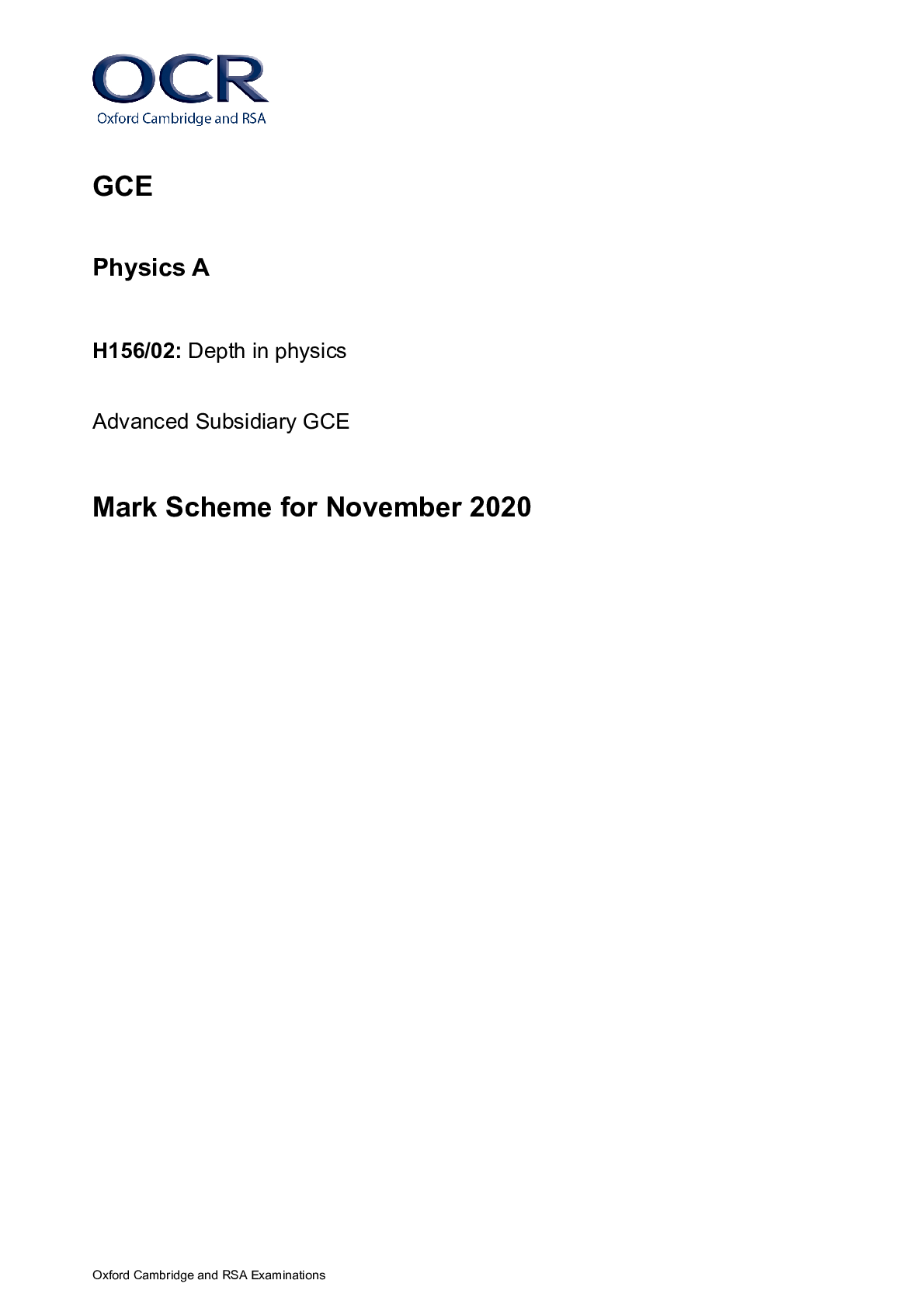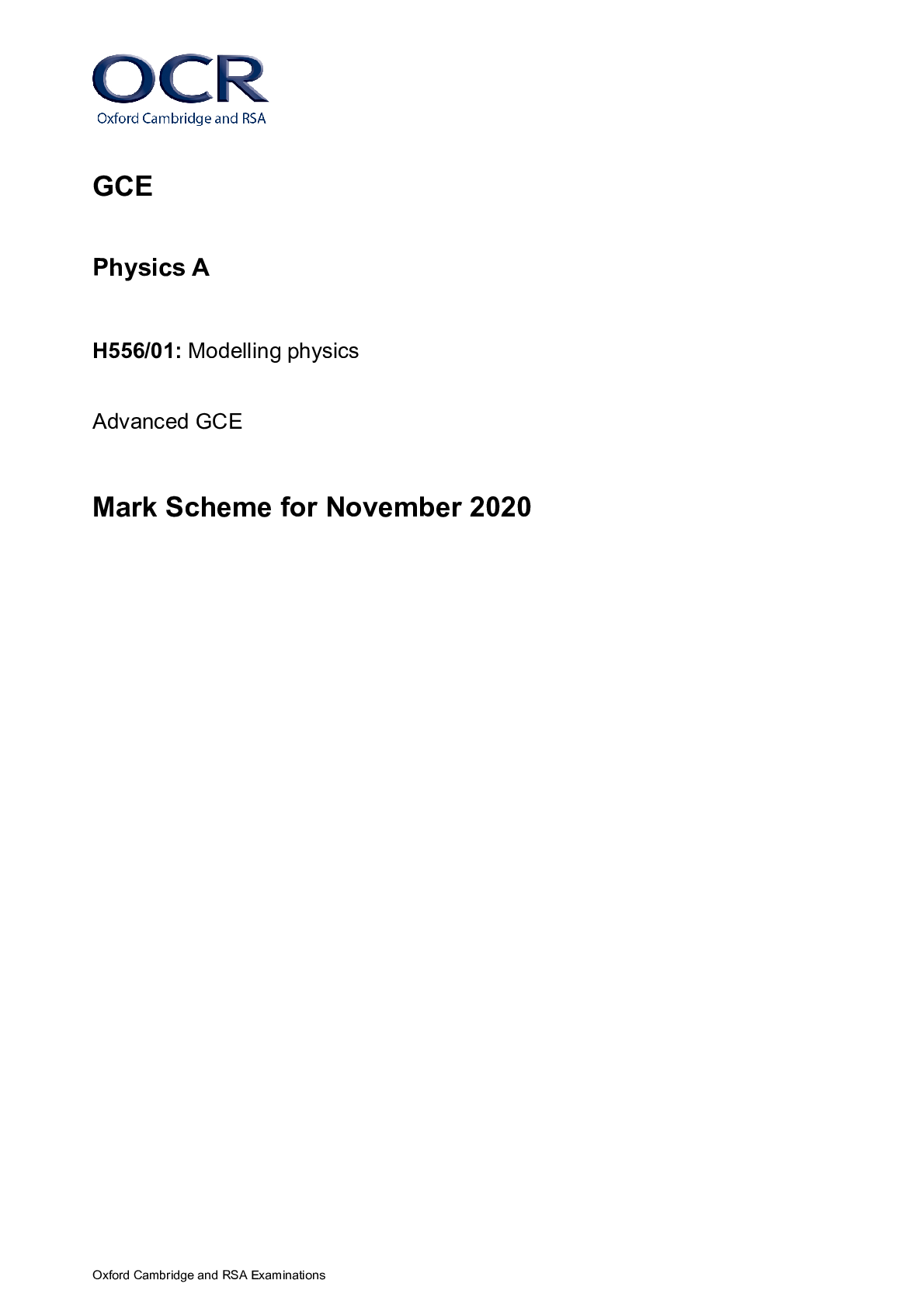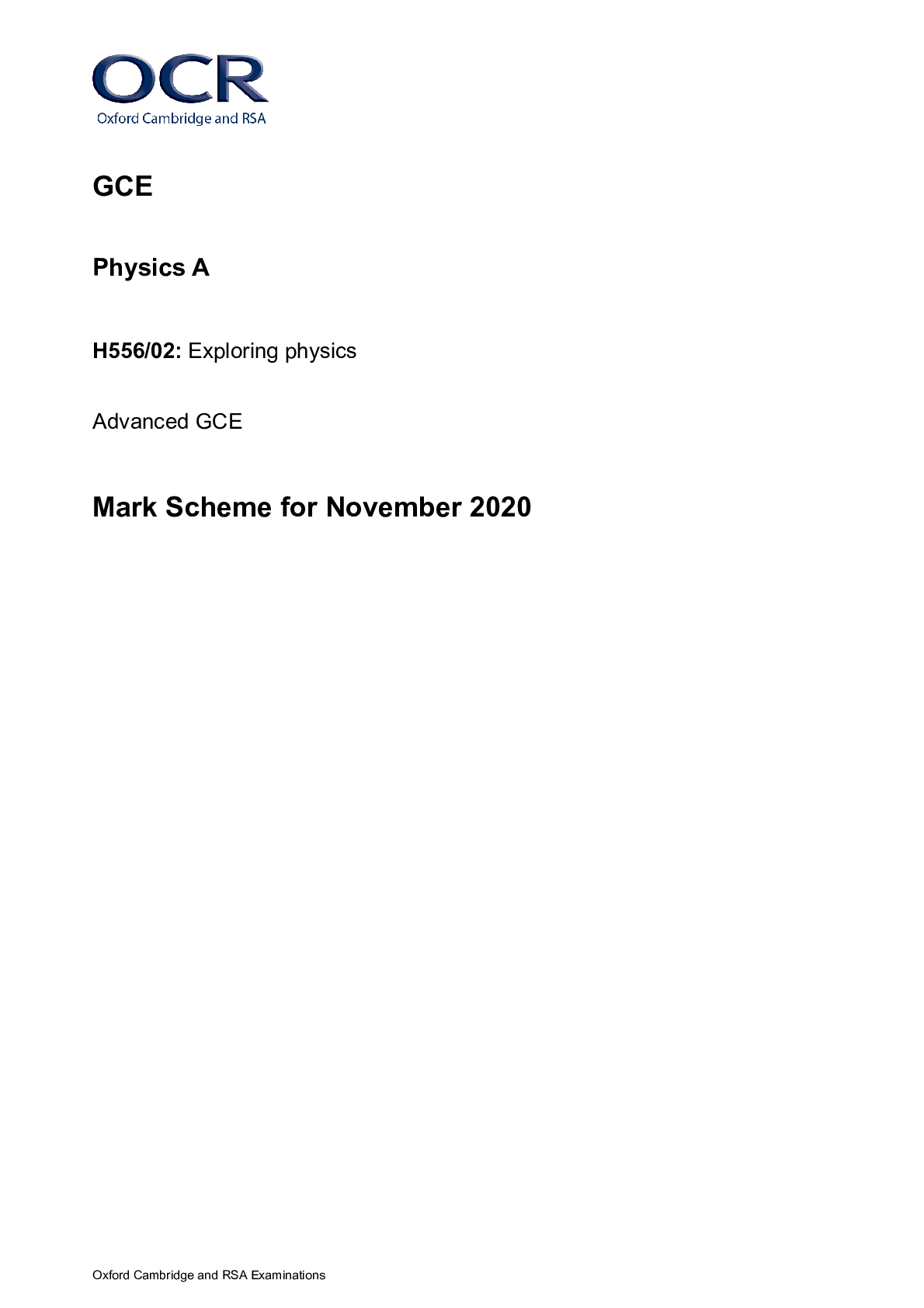History > AS Mark Scheme > GCE History A Y318/01: Russia and its rulers 1855-1964 Advanced GCE Mark Scheme for November 2020 (All)
GCE History A Y318/01: Russia and its rulers 1855-1964 Advanced GCE Mark Scheme for November 2020
Document Content and Description Below
Oxford Cambridge and RSA Examinations GCE History A Y318/01: Russia and its rulers 1855-1964 Advanced GCE Mark Scheme for November 2020Oxford Cambridge and RSA Examinations OCR (Oxford Cambridge... and RSA) is a leading UK awarding body, providing a wide range of qualifications to meet the needs of candidates of all ages and abilities. OCR qualifications include AS/A Levels, Diplomas, GCSEs, Cambridge Nationals, Cambridge Technicals, Functional Skills, Key Skills, Entry Level qualifications, NVQs and vocational qualifications in areas such as IT, business, languages, teaching/training, administration and secretarial skills. It is also responsible for developing new specifications to meet national requirements and the needs of students and teachers. OCR is a not-for-profit organisation; any surplus made is invested back into the establishment to help towards the development of qualifications and support, which keep pace with the changing needs of today’s society. This mark scheme is published as an aid to teachers and students, to indicate the requirements of the examination. It shows the basis on which marks were awarded by examiners. It does not indicate the details of the discussions which took place at an examiners’ meeting before marking commenced. All examiners are instructed that alternative correct answers and unexpected approaches in candidates’ scripts must be given marks that fairly reflect the relevant knowledge and skills demonstrated. Mark schemes should be read in conjunction with the published question papers and the report on the examination. © OCR 2020Y318/01 Mark Scheme November 2020 2 Annotations Annotation Meaning of annotation Blank Page Highlight Off-page comment Assertion Analysis Evaluation Explanation Factor Illustrates/Describes Irrelevant, a significant amount of material that does not answer the question Judgement Knowledge and understanding Provenance Simple comment Unclear View Synthesis Continuity/ChangeY318/01 Mark Scheme November 2020 3 Subject Specific Marking Instructions Section A Mark Scheme Question Answer Mark Guidance 1 Evaluate the interpretations in both of the two passages and explain which you think is more convincing as an explanation of the nature and extent of opposition during the rule of Alexander II. In locating the Interpretations within the wider historical debate, answers might argue that Interpretation A suggests the opposition was mostly in the form of discontent, and primarily from the peasants, as well as middle-classes involved in the zemstva or business. • In evaluating Interpretation A, answers might argue that it is valid as there was a dissatisfaction amongst the peasants following the reforms. • Answers might argue it is valid because of specific peasant concerns, like the redemption payments or terms of landsharing. • Answers might argue that it is valid because the middle-classes were becoming politically aware through zemstvo and this was a cause of resentment. • Answers might argue that it is valid because the peasant confidence in the Tsar meant that opposition was against the government rather than the Tsar. • Answers might argue that it is valid because of reforms that maintained social inequality, such as conscription laws and the legal system. 30 • No set answer is expected • At Level 5 and above answers will evaluate both interpretations, locating them within the wider historical debate about the issue and using their own knowledge, and reach a balanced judgement as to which they consider the most convincing about the issue in the question. • To be valid, judgements must be supported by relevant and accurate material. • Knowledge must not be credited in isolation, it should only be credited where it is used to analyse and evaluate the interpretations, in line with descriptions in the levels mark schemeY318/01 Mark Scheme November 2020 4 • Answers might argue that it is valid because discontent and unrest did not result in significant social or political change. In locating the Interpretations within the wider historical debate, answers might argue that Interpretation B suggests that opposition was radical and originated amongst the intelligentsia. • In evaluating Interpretation B, answers might argue that it is valid because wider access to liberal ideas from universities and abroad made the intelligentsia a core of the opposition. • Answers argue that it is valid because there are examples of radical student actions. • Answers might argue that it is valid because of the changing religious ideas of this opposition group in challenging Orthodox ideas of the state and Tsar. • Answers might argue that it is valid because of the Narodnik opposition action of going to the people. • Answers might argue that it is valid because there was a development of radical organisations as a source of opposition. • Answers may argue that it is not valid because there were forms of opposition that did not originate with the intelligentsia or with foreign ideas. • Answers might argue that it is not valid because the intelligentsia were a tiny minority of the Russian population, and peasant opposition, for example, had the potential to pose a more serious threat had it become organised.Y318/01 Mark Scheme November 2020 5 Section B Mark Scheme Question Answer Mark Guidance 2* ‘There was little change to the living and working conditions of urban and rural people in Russia during the period from 1855 to 1964.’ How far do you agree? In supporting the hypothesis in the question, it might be argued that the working conditions and quality of living stayed fundamentally the same during the period. • Answers might consider the pressure on the working population by the various economic systems, for example problems faced by industrial workers and urban dwellers throughout most of the period. • Answers might consider government policies which consistently negatively impacted on rural workers, for example lack of freedom under the system of serfdom and collectivisation. • Answers might consider the repetition of urban discontent through the period. • Answers might consider the continued need for repressive governmental policies and propaganda to present workers with a positive view of Russia. • Answers might consider that living conditions in Russia always compared unfavourably with the West in each period, indicating there was little improvement. In challenging the hypothesis in the question, answers might argue that there were some notable changes in living conditions. 25 • No set answer is expected • At higher levels answers might establish criteria against which to judge • To be valid, judgements must be supported by relevant and accurate material. • Knowledge must not be credited in isolation; it should only be credited where it is used as the basis for analysis and evaluation, in line with descriptions in the levels mark scheme.Y318/01 Mark Scheme November 2020 6 • Answers might consider the relative improvement of living conditions for key groups at certain times, such as the Kulaks in the 1920s, shock workers in the 1930s and some urbanites in the 1950s and 60s. • Answers might consider the impact of some of Stolypin’s social and agricultural reforms. • Answers might consider the increasing urbanisation to challenge the idea that there was little change to living and working conditions. • Answers might consider the efforts under Lenin (NEP) and Stalin (2nd Five Year Plan) to address consumer needs. • Answers might consider the efforts under Khrushchev to produce consumer goods like televisions and cars. 3* “The wars that Russia fought in the years from 1855 to 1964 always hindered economic development.” How far do you agree? In supporting the hypothesis in the question, it might be argued that wars had a negative impact on the economic growth of Russia. • Answers might consider the economic problems of the efforts to reform following the Crimean War, such as problems with the division of land. • Answers might consider the impact of WW1 on the Russian economy, as it led to shortages, inflation and economic difficulty in the short term, plus the loss of land and resources in the medium term. • Answers might consider the negative impact of the Russian Civil War on the Russian economy. 25 • No set answer is expected • At higher levels answers might establish criteria against which to judge • To be valid, judgements must be supported by relevant and accurate material. • Knowledge must not be credited in isolation; it should only be credited where it is used as the basis for analysis and evaluation, in line with descriptions in the levels mark scheme.Y318/01 Mark Scheme November 2020 7 • Answers might consider the impact of the ‘scorched earth’ policy in WW2 on the Russian economy. • Answers might consider the impact of the Cold War, for example the cost of starting a nuclear and space race. In challenging the hypothesis in the question, answers might argue that there were some instances of war helping the economy, and/or that there were more important factors in slowing the economy. • Answers might consider the focus on industrialisation in Russia under Witte as a result of defeat in earlier wars. • Answers might consider the link between the Civil War and introduction of the New Economic Policy (NEP). • Answers might consider that some communist policies which arose as a consequence of the 1917 Revolution and Bolshevik victory in the Civil War developed the economy. • Answers might consider Stalin’s focus on industrialisation in part due to a fear of foreign invasion based upon previous wars. • Answers might consider the impact of the WW2 war economy in the post-war period, supported by foreign funding. 4* "Russian governments had the most secure control of national minorities and satellite states after 1945". How far do you agree with this view of the period from 1855 to 1964? In supporting the hypothesis in the question, it might be argued that the prior to the establishment of 25 • No set answer is expected • At higher levels answers might establish criteria against which to judge • To be valid, judgements must be supported by relevant and accurate material.Y318/01 Mark Scheme November 2020 8 clear satellite states after WW2, national minorities were a challenge for the government. • Answers might consider the challenge of nationalities in the 1800s with problems of cultural identity. • Answers might consider the strength of Soviet control of satellite states 1945-64, for example Hungary in 1956. • Answers might consider the loss of national minority areas in the Treaty of Brest-Litovsk. • Answers might consider the Russian defeat in the Russo-Polish War. • Answers might consider the difficulties faced in Manchuria whilst expanding Russian control. In challenging the hypothesis in the question, answers might argue that there was always strength in the control of national minorities, and/or that the control of post-WW2 satellite states was not consistent. • Answers might consider the strength of Russification under the Tsars. • Answers might consider the the use of pogroms and laws to dominate Jewish minorities. • Answers might consider the control of Finland and the Baltic Provinces. • Answers might consider the actions of Tito in Yugoslavia as a challenge to Soviet control. • Answers might consider Soviet weakness in East Berlin. • Knowledge must not be credited in isolation; it should only be credited where it is used as the basis for analysis and evaluation, in line with descriptions in the levels mark scheme.Y318/01 Mark Scheme November 2020 9 APPENDIX 1 – this contains a generic mark scheme grid AO3: Analyse and evaluate, in relation to the historical context, different ways in which aspects of the past have been interpreted. Generic mark scheme for Section A, Question 1: Interpretation [30] Level 6 26–30 marks The answer has a very good focus on the question throughout. It has thorough and sustained evaluation of the interpretations, using detailed and accurate knowledge of the historical context and the wider historical debate around the issue, in order to produce a convincing and supported analysis of them in relation to the question. Level 5 21–25 marks The answer has a good focus on the question throughout. It has good evaluation of the interpretations, using relevant knowledge of the historical context and the wider historical debate around the issue, in order to produce a supported analysis of them in relation to the question. Level 4 16–20 marks The answer is mostly focused on the question. It has evaluation of the interpretations based on generally relevant knowledge of the historical context and the wider historical debate around the issue, in order to produce an analysis of them in relation to the question. Level 3 11–15 marks The answer is partially focused on the question. It has partial evaluation of the interpretations based on some knowledge of the historical context and the wider historical debate around the issue. There may be some use of information from one of the two interpretations to support the evaluation of the other, but the evaluation will not rely on this. There is a limited analysis of the interpretations in relation to the question. Level 2 6–10 marks The answer has a limited focus on the question. Parts of the answer are just description of the interpretations, with evaluation in relation to historical context and the wider historical debate around the issue being weak, and evaluation relying heavily on information drawn from the other interpretation. There is a very limited analysis of the interpretations in relation to the question. Level 1 1–5 marks The answer has some relevance to the topic, but not the specific question. The answer consists mostly of description of the interpretations with very limited evaluation based on very generalised knowledge of historical context and minimal or no reference to the wider historical debate. Analysis of the interpretations in relation to the question is either in the form of assertion or lacking. 0 marks No evidence of understanding and no demonstration of any relevant knowledge.Y318/01 Mark Scheme November 2020 10 AO1: Demonstrate, organise and communicate knowledge and understanding to analyse and evaluate the key features related to the periods studied, making substantiated judgements and exploring concepts, as relevant, of cause, consequence, change, continuity, similarity, difference and significance. Generic mark scheme for Section B, Questions 2, 3 and 4: Essay [25] Level 6 21–25 marks The answer has a very good focus on the question. Detailed and accurate knowledge and understanding is used to analyse and evaluate key features of the period studied in order to reach a fully developed synthesis supporting a convincing and substantiated judgement. There is a well-developed and sustained line of reasoning which is coherent and logically structured. The information presented is entirely relevant and substantiated. Level 5 17–20 marks The answer has a good focus on the question. Generally accurate and detailed knowledge and understanding is used to analyse and evaluate key features of the period studied in order to reach a developed synthesis supporting a substantiated judgement. There is a well-developed line of reasoning which is clear and logically structured. The information presented is relevant and in the most part substantiated. Level 4 13–16 marks The answer is mostly focused on the question. Relevant knowledge and understanding is used to analyse and evaluate key features of the period studied in order to reach a synthesis supporting a reasonable judgement. There is a line of reasoning presented with some structure. The information presented is in the most-part relevant and supported by some evidence. Level 3 9–12 marks The answer has a partial focus on the question. Some relevant knowledge and understanding is used to analyse and explain key features of the period studied in order to attempt an undeveloped synthesis, which is linked to a judgement, though the supporting explanation may lack detail and clarity. The information has some relevance and is presented with limited structure. The information is supported by limited evidence. Level 2 5–8 marks The answer has only a limited focus on the question. Limited relevant knowledge and understanding is used to give a limited explanation and analysis of key features of the period studied. There is a judgement but this may not be clearly linked with the supporting explanation. The information has some relevance, but is communicated in an unstructured way. The information is supported by limited evidence and the relationship to the evidence may not be clear.Y318/01 Mark Scheme November 2020 11 Level 1 1–4 marks The answer has a limited focus on the topic, but not the specific question. The answer is largely descriptive, with only very generalised knowledge of the period studied being used to attempt basic explanation and very limited analysis. Judgements are unsupported and are not linked to analysis. Information presented is basic and may be ambiguous or unstructured. The information is supported by limited evidence. 0 marks The answer contains no relevant information.Y318/01 Mark Scheme November 2020 12 APPENDIX 2 – this section contains additional subject specific information Use this space if you have extensive subject specific information that is inappropriate to include elsewhere.OCR (Oxford Cambridge and RSA Examinations) The Triangle Building Shaftesbury Road Cambridge CB2 8EA [Show More]
Last updated: 1 year ago
Preview 1 out of 14 pages
Instant download

Buy this document to get the full access instantly
Instant Download Access after purchase
Add to cartInstant download
Reviews( 0 )
Document information
Connected school, study & course
About the document
Uploaded On
Oct 10, 2022
Number of pages
14
Written in
Additional information
This document has been written for:
Uploaded
Oct 10, 2022
Downloads
0
Views
64

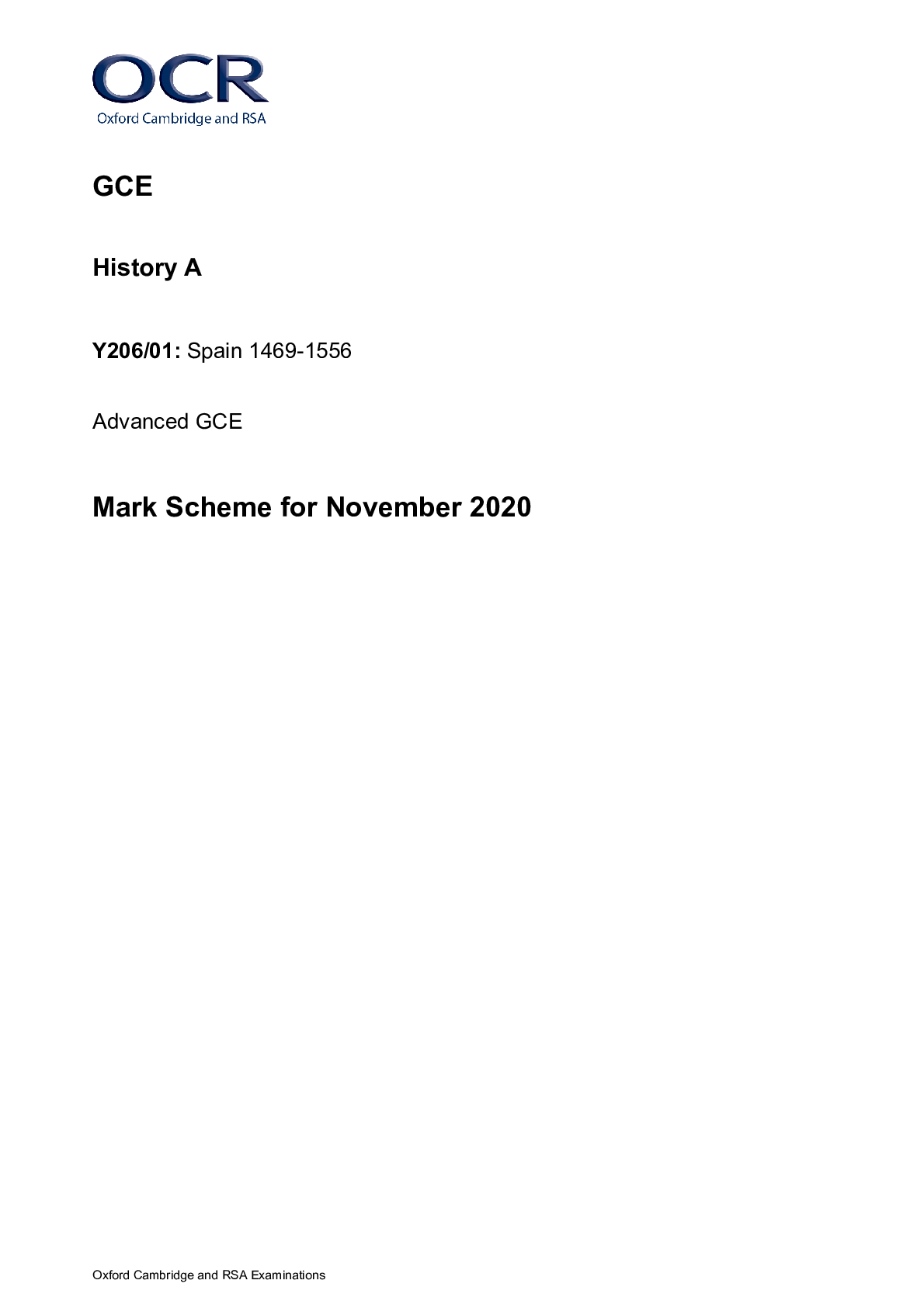
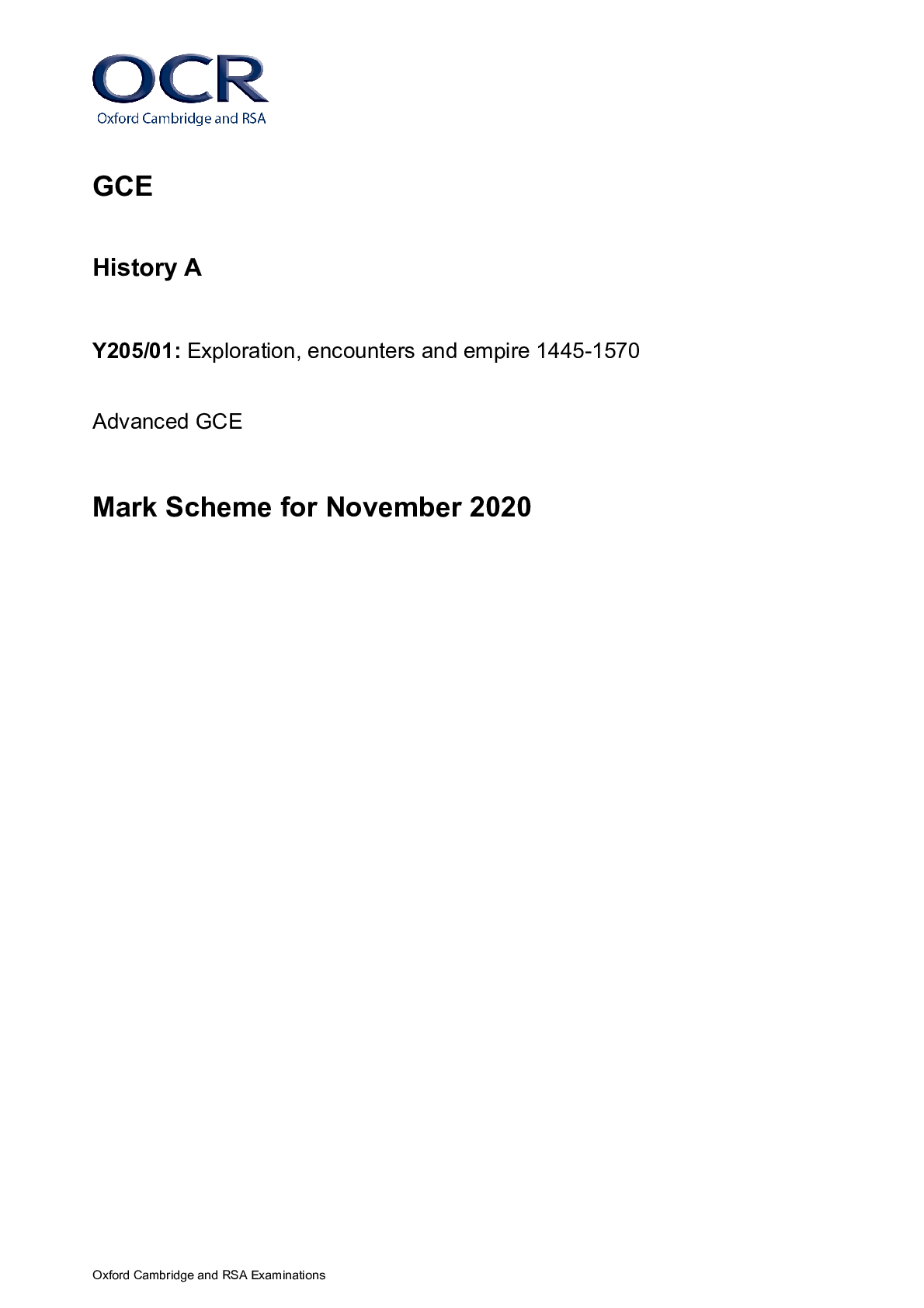






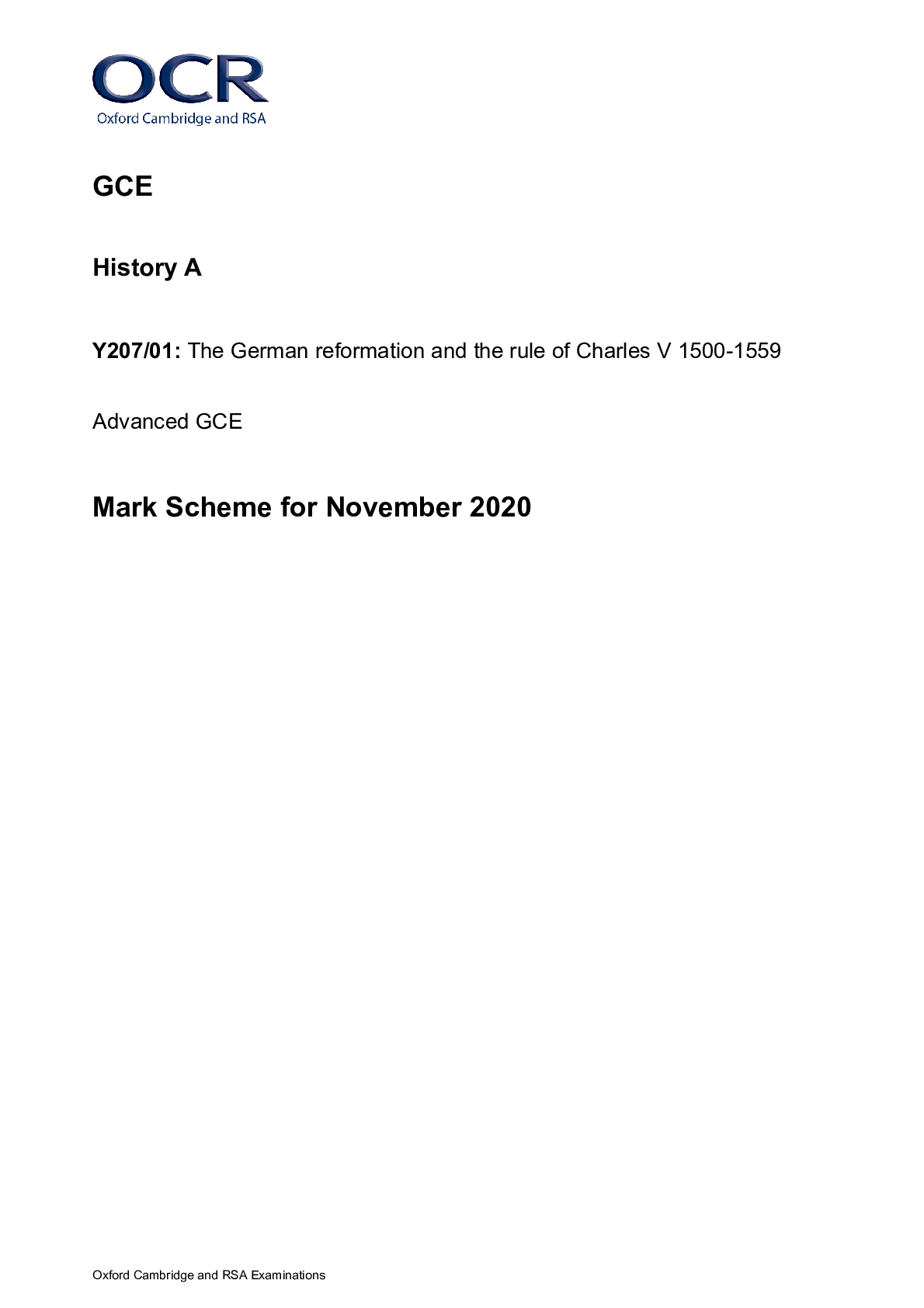






.png)



